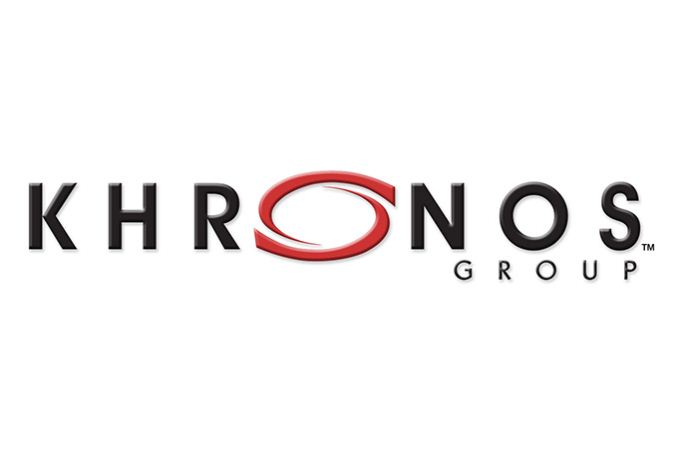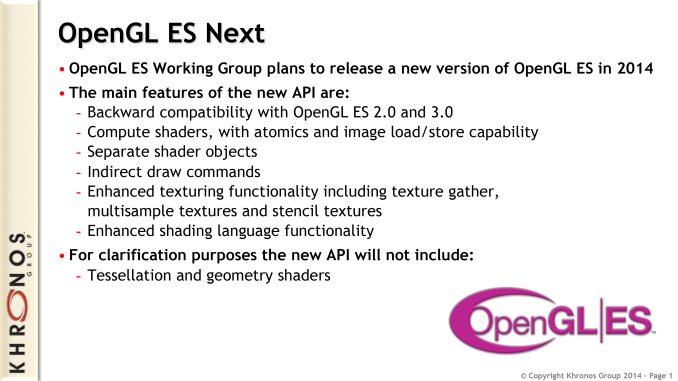Khronos Offers a Quick Peek at the Next Version of OpenGL ES
by Ryan Smith on January 8, 2014 11:00 AM EST
Amidst the hustle and bustle of CES 2014, Khronos has published a short announcement regarding the next version of OpenGL ES (OpenGL ES Next). In it they are offering a brief high level overview of their plans for their mobile graphics API.
In short, Khronos is announcing that they will be releasing OpenGL ES Next this year, which would put it roughly 2 years after the release of OpenGL ES 3.0. As is expected it will come with several new features – many of these being brought over in some form from mainline OpenGL – while at the same time continuing to walk the narrow line between being a separate API and a pure subset of OpenGL.
Feature wise, OpenGL ES Next will bring with it support for a number of features that were introduced in OpenGL 4.x. This includes compute shaders (OGL 4.3), shader atomics with load/store capabilities (OGL 4.2), indirect draw commands (OGL 4.0), texture multi-sampling (OGL 3.2). All of these features will be important additions to the API for different reasons, be it increasing the capabilities and performance of the shader system, or further adding onto the functionality of the texturing system. The addition of compute shaders will likely be the marquee feature for OpenGL ES Next, but that shouldn’t discount the importance of the other feature additions.
Meanwhile Khronos has also offered a brief glimpse of what they won’t be including, in order to better illustrate where they’re going with OpenGL ES Next and how it compares to other APIs. OpenGL ES Next will not be including some of OpenGL’s high-end geometry functionality, specifically geometry shaders (OGL 3.2) and tessellation (OGL 4.0). Just as how OpenGL ES 3.0 isn’t quite at feature parity with OpenGL 3, these omissions mean that OpenGL ES Next will still have some significant differences compared to OpenGL 4, and even OpenGL 3 again. In other words, just as how OpenGL ES 3.0 was in many ways a reduced scope version of OpenGL 3, OpenGL ES Next will continue that trend by being a reduced scope version of OpenGL 4.
Wrapping things up, with a publication date set for this year, it’s a solid bet that we should hear more about OpenGL ES Next towards the middle of this summer. Khronos’s major announcements typically come around SIGGRAPH (Aug. 10-14, 2014), with OpenGL ES 3.0 and OpenGL 4.4 being announced at that show in previous years, so that’s where we’d expect Khronos to announce at least a preliminary draft of Open GL Next, if not the final version.
Special thanks to our own Rahul Garg for catching this announcement
Source: Khronos











19 Comments
View All Comments
da_asmodai - Wednesday, January 8, 2014 - link
I think you misread my post. I wasn't saying companies were going from OpenGL to DirectX. I was saying companies were going from OpenGL ES 3.0 to the full OpenGL (which typically means they also offer DirectX support if their GPU is used in a MS system)B3an - Wednesday, January 8, 2014 - link
Thats not true, a lot of Autodesk software will use DirectX, and sometimes the software will only have options that will work with DX, or even be DX only. It's not always exactly CAD software but similar type of stuff (3D modelling and/or animation).Krysto - Wednesday, January 8, 2014 - link
No. ES is the future, not just for mobile, but for *all* GPU computing (okay, maybe not for supercomputers, but up to PC's at least).The reason is because the full OpenGL is a mess, and there have been many tries to break free from the legacy cruft of OpenGL, without any success. ES is the answer to that, because it incorporates only the features that are needed for mobile, so only the high-efficiency features, and it will keep adding (smartly) more features as it evolves.
That being said, Nvidia still has a major advantage with Kepler in Tegra K1, because no other mobile GPU will come even close to feature parity, and even OpenGL ES Next, won't have everything, but I suppose it will have most of the important stuff for mobile, while the others are probably too inefficient to use in mobile anyway (although it does probably making the life of developers who just want to port their PC/PS4 games to mobile much easier).
But even OpenGL ES Next won't be available until 2016. They're barely finalizing it next year, and it will take at least a year more to be adopted in shipping chips. So the founder of Epic Games was right in Nvidia's promo demo when he said he didn't expect the Tegra K1 capabilities to be available for 3-4 years (and that's what it would've happened, if Nvidia didn't release K1 now, which just forces everyone else to move a little fast, but it will still take another 2 years).
djgandy - Wednesday, January 8, 2014 - link
It's just more hot air from nvidia though. The reason those features do not currently exist in the mobile space, tessellation and the like is because they are not deemed a good use of area, which they aren't.Supporting the latest full desktop OpenGL features is great, as well as dx11 (which I doubt will be full feature level) , but what percentage of mobile does that give you? Windows RT and mobile?! This is an ARM chip remember.
SoC makers want small chips and power efficient chips, adding features that cannot be used satisfies neither of those requirements and means in all likelihood tegra will be much larger than competitors.
djgandy - Wednesday, January 8, 2014 - link
Also you are very nvidia biased. How is K1 available now? It is no more now from an announcement an OpenGL ES next is from this announcement. You'll be lucky if you see a K1 product by the end of the yearMrSpadge - Thursday, January 9, 2014 - link
Thanks for that explanation - since some time I was wondering what the deal was with this ES version and why and where it "suddenly" came from.stefstef - Friday, January 10, 2014 - link
sooner or later you are surely right. in a couple of years you can play todays high endgames on your smartphone connected to your 4k display, which has become the lowest
standard and is already outshone by those brilliant new 16k displays.
alexvoica - Thursday, January 9, 2014 - link
All PowerVR Rogue GPUs (Series6/Series6XT/Series6XE) are designed to fully support OpenGL ES Next.relativegames - Friday, January 10, 2014 - link
It seems some of the comments are inacurate. I'm a game developer and I work with GL/DX every day. Some notes :- tesselation. The GL 4.0 offers tesselation as a shader stage which is completely programable and offers very large capabilities. The tesselation that Qualcomm or other mobile companies are talking about is instanced tesselation. This is as much "hardware" as the first one with a lot differences, one that is not as efficient, not as flexible and you have to implement the tesselation algorithm in software(cpu) which is again less effective. I've actually done this but the current Adreno 320/330 drivers crash when they try and compile the shader.
OpenGL the desktop version is indeed a mess, nobody wants "full" opengl anywhere.
Some companies will say their GPU supports DirectX11 when they refer to the API used not the feature level. Windows Phone 8 uses the DirectX 11.1 API with feature level 9_3. As for PowerVR supporting DX10 or OpenGL 3.2, i kind of doubt it, there are no GL ES 3 extensions that would add optional geometry shaders, actually there's no GLES3 extension at all right now and most ES3 implementations suck in some areas, the drivers do not support everything that was intented, like the tesselation rash i mentioned earlier. Maybe the 420 driver will fix it but I reported the issues since August 2013, so yeah they're still working on es 3 support.
If Khronos doesn't make new specs and if gpu companies don't add more features into OpenGL ES you can be sure that developers won't be interested in making or porting hardcore games for mobile, first he specs, then the games.